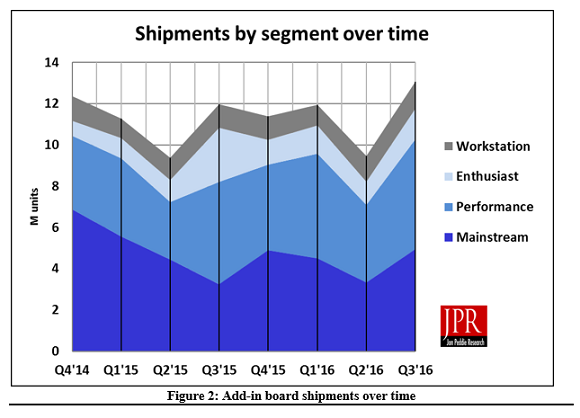Discrete Desktop GPU Market Trends Q3 2016: GPU Shipments Hit Two-Year High
by Anton Shilov on November 28, 2016 9:00 AM ESTGaming GPUs Are Gaining Traction, But Mainstream GPUs Are Still Strong
In our overview of Q2 2016, we mentioned that shipments of higher-end graphics processors were growing, whereas sales of mainstream GPUs were declining in the recent years as a result of major improvements of AMD’s integrated graphics and Intel’s iGPUs. In particular, sales of enthusiast-class adapters hit 5.9 million units in 2015, which was a record. This year is not that good for expensive graphics cards, but shipments of gaming-grade desktop GPUs are still very high.
Sales of enthusiast-class desktop AIBs in Q3 2016 were considerably lower than sales of enthusiast-class standalone desktop GPUs in the same period a year ago. Nonetheless, we are still talking about around ~1.5 million units, which seems to be higher than what we have seen historically. Moreover, since JPR considers everything that costs between $250 and $900 as “enthusiast”, it is obvious that unit shipments do not necessarily reflect revenues earned by AMD and NVIDIA. Moreover, since AMD and NVIDIA officially sell the Radeon RX 480 and the GeForce GTX 1060 for $249 and demand for these products (which performance is on par with much more expensive predecessors) was probably very high during the quarter, it is likely that some of the “enthusiast” buyers were classified as “performance” ($249 and below) buyers in Q3 2016.
| Fall 2016 GPU Pricing Comparison | ||||||
| Market Segment | AMD | Price | NVIDIA | |||
| Enthusiast $250 - $900 |
$1200 | TITAN X (Pascal) | ||||
| $599 | GeForce GTX 1080 | |||||
| $379 | GeForce GTX 1070 | |||||
| Performance $100 - $249 |
Radeon RX 480 (8GB) | $249 | GeForce GTX 1060 6GB | |||
| Radeon RX 480 (4GB) | $229 | |||||
| Radeon RX 470 | $199 | GeForce GTX 1060 3GB | ||||
| $139 | GeForce GTX 1050 Ti | |||||
| Radeon RX 460 (4GB) | $119 | |||||
| Radeon RX 460 (2GB) | $109 | GeForce GTX 1050 | ||||
| Mainstream <$99 |
No New GPUs | <$100 | No New GPUs | |||
Despite the fact that shipments of higher-end standalone video cards dropped year-over-year (YoY) in the third quarter, gaming-grade graphics adapters (enthusiast + performance) hit around seven million units. The industry still supplied over five million of mainstream boards in Q3, which is quite a lot. Nonetheless, performance and enthusiast-class desktop AIBs have been outselling mainstream graphics cards for five consecutive quarters now.











53 Comments
View All Comments
RussianSensation - Friday, December 2, 2016 - link
I5 2500K/2600K turn 7 years old next month, since they were released on January 2011!catavalon21 - Sunday, December 11, 2016 - link
How about splitting the difference, and call it 6 years old?Araa - Monday, November 28, 2016 - link
Never been an AMD fan myself but I hope they get out of the slumber they are currently in. I want the good ol' 2010 days back where they were a strong second.Keao - Monday, November 28, 2016 - link
Yeah and back then GPU mid-tier was a bargain :-)Aaaah I miss the days of the RADEON HD4870...
Stuka87 - Monday, November 28, 2016 - link
In 2010 AMD was in first place. Thats back when the 5000 series was king of the hill and the GTX 400 series was delayed 6 months and shipped as a power guzzling pig. It was later on when the updated 500 series brought nVidia back in front as the AMD 6000 series was just a basic re-badge.silverblue - Tuesday, November 29, 2016 - link
Not quite; the 6900 series moved from VLIW5 to VLIW4 due to AMD realising that the average slot utilisation was 3.4, hence there were efficiency gains to be made in reducing the size of each shader block. The 6870 and below were based off the 5000 series, however.just4U - Friday, December 2, 2016 - link
While the 470/80 were guzzlers for sure .. the 460 was the little darling... priced well and gave Nvidia fans something to cheer about. The 500 series certainly brought more to the table, however AMD was matching them in performance while beating them on pricing...I always remember wanting a 560Ti or a 570 but could never justify it on the price so opted for the AMD equivalent... sad to because even as it was about to be discontinued the damn cards never did come down in price. That's when I started to get a little miffed with Nvidia. After the TNT2 They really began to sock it to you price wise with the Geforce line... That's something ATi never really did... even when they were the king of graphics in the early 90s.
Strunf - Thursday, December 8, 2016 - link
ATI/AMD, nVIDIA will charge as much as they can... there are no good guys, they are quoted on the stock market and hence profit driven.In the early 90s the graphics card wasn't so important and there were a few players ATI, S3, Matrox, Intel... then the 3D accelerators kicked in and the market went crazy.
Samus - Tuesday, November 29, 2016 - link
I haven't had an AMD GPU since AMD bought ATI that I liked. They were cheaper, for the same performance as nVidia, but they failed early, the drivers were awful, and their partners were and still are lousy. AMD doesn't have an equivalent OEM builder to nVidia such as PNY or EVGA.And before you laugh about PNY, remember that PNY is actually the largest distributor of nVidia cards. By quite a lot. I remember reading a few years ago that PNY shipped more cards than every other nVidia partner COMBINED. All those Quadro's have helped their bottom line as well.
peterfares - Wednesday, November 30, 2016 - link
ASUS makes AMD cards. They're reputable.